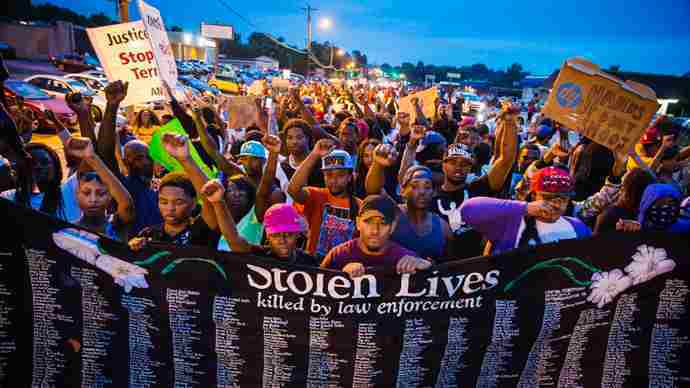ST. LOUIS, Mo. – In a victory for protesters in Ferguson and their call to stop police abuse against peaceful demonstrations, the St. Louis City and County police departments, as well as the Missouri State Highway Patrol, reached an agreement with civil rights lawyers. The agreement limits the use of tear gas, smoke, pepper spray or other chemical agents against protesters without first giving a clear warning and a means of exit. The new policy – to be decreed by the law enforcement agencies by August 2015, and detailed in a settlement agreement dismissing demonstrator’s lawsuit against the law enforcement agencies – also prohibits police from using chemical agents as a method for dispersing individuals engaged in peaceful protest, or for intimidating or punishing them for exercising their First Amendment rights.
A restraining order issued in December by Federal District Judge Carol Jackson, limiting police use of chemical agents, remains in place until the new policies are codified by the agencies.
The agreement dismisses a federal civil rights lawsuit brought by Advancement Project, Arch City Defenders and the St. Louis University Law Clinic on behalf of 10 protesters who have been demonstrating in Ferguson and throughout the St. Louis area to demand justice in the police shooting death of Michael Brown. The suit was filed against the three policing agencies, which oversaw police operations during the demonstrations that followed the death of Michael Brown and the grand jury’s decision not to indict the officer who killed him. During those demonstrations, protesters were met with a highly militarized police response, including use of tear gas and other chemical agents.
As part of the settlement agreement, the departments agreed to implement policies making the terms of the restraining order permanent. They also agreed to ongoing court oversight of the departments for three years. The move is significant, as the parties are aware of only one other police agency in the nation (the Oakland Police Department) with policies that limit the use of chemical agents. It is the power of the plaintiffs’ stories – including young people who had been subject to tear gas multiple times without warning, while either demonstrating or observing protests in Ferguson and St. Louis – that led to the judge’s historic restraining order that forms the foundation for the agreement today.
“This victory rests on the shoulders of the courageous protesters who are tirelessly demonstrating in the streets of Ferguson, and it’s a testament to the powerful movement they have fostered,” said Thomas Harvey, co-counsel and executive director of Arch City Defenders, a St. Louis region nonprofit law firm. “We are pleased that the police are now affirming their constitutional right to keep demonstrating without undue fear of tear gas and other chemical agents.”
“We had not seen this kind of excessive police force used against protesters since the Civil Rights Movement of the 1960s,” said Denise Lieberman, co-counsel and senior attorney for the national civil rights organization Advancement Project. “Particularly in movements for racial justice, it is imperative that protesters have a presence in the street and put the issues directly in front of people’s faces. The use of tear gas in Ferguson has been a tactic to chill this movement, and today’s consent decree will finally put a stop to those efforts.”
Among the 10 plaintiffs who gave testimony in the emergency hearing against the use of chemical agents were Millennial Activists United co-founders Alexis Templeton, 21, and Brittany Ferrell, 25, who have both been subject to tear gas without warning while protesting. The federal court also heard from Kira Banks, 35, a local professor who was sprayed with tear gas without warning, and a 31-year-old who was sprayed with tear gas and had guns pointed at him by police while serving as a legal observer.
“For the past several months, tear gas had been liberally used in Ferguson and St. Louis against protesters, and many people don’t understand just how dangerous it truly is,” said Brendan Roediger, co-counsel and a law professor with the St. Louis University Legal Clinic. “Tear gas is a chemical agent that is precluded from use in warfare, with major physical and psychological impacts. It has no place being used to suppress protest activity in our community.”
“Using tear gas and other agents is a tactic to wrongly paint protesters as violent, and discredit what they have to say,” said Justin Hansford, co-counsel and an assistant professor of law at St. Louis University. “With this consent decree, St. Louis police will no longer be able to use chemical agents as a way to undermine the movement and its message.”


